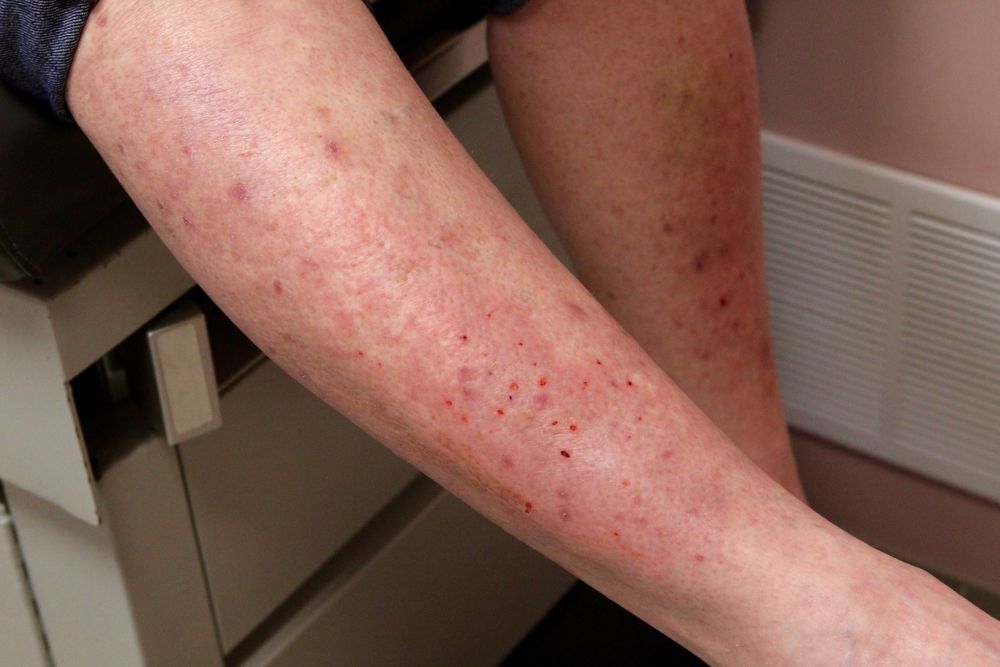Dermatitis Herpetiformis Treatment Options (Celiac Rash)
Celiac disease is caused by autoimmune reactions that impair the small intestine’s lining. Patients with celiac disease often develop dermatitis herpetiformis (DH) because of adverse reactions to gluten. (Learn More) Luckily, once the source of dermatitis herpetiformis is found, it can be treated. (Learn More) Changes in diet are crucial to preventing outbreaks of DH, but they can be difficult to maintain. (Learn More) There are also approved medical treatments, such as the medication Dapsone, that can help.
How Does Dermatitis Herpetiformis Start?
Patients with celiac disease often face dermatitis herpetiformis (DH) when they accidentally ingest gluten. The Celiac Disease Foundation reports that DH, also known as Duhring’s disease or celiac rash, causes blisters or itchy bumps. These often appear on the elbows, forearms, hairline, knees, and groin area. The name herpetiformis comes from the appearance of these rashes, which are said to look like herpes rashes. However, the herpes simplex virus has nothing to do with DH. Some celiac patients may have difficulty getting a proper diagnosis, as they may be erroneously diagnosed with eczema instead. DH causes mouth problems, such as discoloration of tooth enamel. Celiac disease is a problem of the small intestine, and people with dermatitis herpetiformis may also experience these symptoms:
Constipation
Diarrhea
Bloating
Cramps in the abdominal area
DH tends to come in waves that dissipate. The Celiac Disease Foundation says that 10 to 15 percent of patients with celiac disease may get dermatitis herpetiformis. This skin reaction normally presents itself in people who are between 30 and 40 years old. It is more common in Caucasian patients, and it less frequently appears in African American or Asian patients. Men are more likely to suffer from DH than women.
Description of a DH Rash
Dermatitis herpetiformis starts out as a red, itchy rash. Patients often report getting the rash at the same place every time. Look for red bumps that resemble pimples and contain a clear liquid in them.
How DH Is Diagnosed
Per Healthline, dermatitis herpetiformis is usually diagnosed via a skin biopsy. This means your doctor will extract a small sample of your skin and look at it under a microscope. This test can also help to determine if your rash is the result of something else. In some cases, the skin sample will be dyed to show antibodies that may be causing DH. If warranted, your doctor may also run a blood test to check for antibodies, and they may do a biopsy of your small intestine to check for damage. A May 2015 case study in Clinical, Cosmetic, and Investigational Dermatology says that dermatitis herpetiformis may manifest itself as a skin issue, but it is an autoimmune reaction that could signal additional health issues that may affect the patient.
Available Treatments
Once dermatitis herpetiformis is diagnosed, you will likely receive treatments that can ease symptoms or prevent future skin rashes. The two most recommended treatments are:
Dapsone. This is a medication that treats skin lesions from leprosy and other agents, according to MedlinePlus. It could be taken anywhere from three times weekly to once daily. This medication is associated with these side effects:
Skin becoming more sensitive to sunlight
Upset stomach, though taking the medication with food can help
Vomiting
Fever
Increased bruising
Diet changes.
Avoiding gluten is known to prevent DH outbreaks.
What About a Gluten-Free Diet?

Per Mayo Clinic, a gluten-free diet simply means avoiding gluten. This protein is most commonly found in wheat, grains, barley, rye, and triticale (a genetically crossed form of rye and wheat). Healthline reiterates that in people with celiac disease, gluten causes a harmful autoimmune response that results in deterioration of the small intestine. A gluten-free diet is essential to preventing DH and other damage that can occur in patients with celiac disease. There are some obstacles for this life change.
You must ensure that you get the necessary amount of calories, fiber, and nutrients once you remove gluten-containing items from your diet.
You must avoid products with gluten altogether. This can be difficult as they are common dietary staples in many cuisines.
Eating in certain social situations can be tough.
A gluten-free diet is sometimes also called the celiac disease diet. The following are benefits of following this diet:
Decrease in harmful autoimmune reactions
Preventing future harm to the small intestines
Possible reduction of cancer risk
Improved fertility
Better nutrient absorption
Possibly reduced risk for osteoporosis
Adhering to the diet requires patience and persistence. It can take months or years for the diet to control symptoms of dermatitis herpetiformis.
Examples of Foods You Can Eat on a Gluten-Free Diet
The celiac disease diet allows for many foods. The following are examples
Eggs
Legumes and nuts, such as beans and seeds that have not been processed
Fresh fruits and vegetables
Lean meats, fish, and poultry that are unprocessed
Low-fat milk and dairy
The following grains are permitted in a gluten-free diet:
Quinoa
Rice
Tapioca
Soy
Corn or cornmeal
These foods should be avoided completely:
Rye
Barley
Wheat
Oats
Oats are free of gluten, but they may become contaminated if handled with products containing gluten. Some patients with celiac disease have had adverse reactions to oats that are labeled as gluten-free.
Frequently Asked Questions
What are the causes of dermatitis herpetiformis (DH)?
Dermatitis herpetiformis is common in people with celiac disease. The rash appears as a result of eating a product containing gluten. This causes an adverse autoimmune reaction that harms the small intestine and shows up as a skin rash involving red bumps resembling acne. The rash is often accompanied by a burning or stinging sensation.
What are some common treatments for DH?
Your doctor may prescribe Dapsone, a medication known to aid with skin lesions. This should assist with rashes that are already occurring. A gluten-free diet is the best way to prevent DH outbreaks in the long term.
How can a gluten-free diet help me better deal with DH?
Gluten is a protein found in many wheat-containing products, as well as rye and barley. Unfortunately, people with celiac disease cannot tolerate this protein because it is harmful to their small intestine. Avoiding gluten prevents dermatitis herpetiformis, future damage to the small intestine, and cramping and bloating that could occur when you accidentally eat gluten. Your doctor can provide you with specifications and offer nutritional advice.
References
Dermatitis Herpetiformis. Celiac Disease Foundation.
The Diagnosis and Treatment of Dermatitis Herpetiformis. (May 2015). Clinical, Cosmetic, and Investigational Dermatology.
What to Know About Dermatitis Herpetiformis. (February 2019). Medical News Today.
Dapsone. (May 2017). MedlinePlus.
Gluten-Free Diet. (November 2017). Mayo Clinic.
Celiac Disease Diet, Food Lists, Sample Menu, and Tips. (January 2019). Healthline.
Dermatitis Herpetiformis and Gluten Intolerance. (August 2017). Healthline.
What Dermatitis Herpetiformis Looks Like. (April 2019). Verywell Health.
Managing Your Dermatitis Herpetiformis With the Gluten-Free Diet. (October 2018). Verywell Health.

Related Articles

Alzheimer's Treatment
Alzheimer’s disease is a progressive disease that...

Overview of Common Vision Problems & Medications
Medication is not always necessary or the best choice...

Dermatitis Herpetiformis Treatment Options (Celiac Rash)
Celiac disease is caused by autoimmune reactions that...

Nonaddictive Medications for Anxiety
There are a number of nonaddictive medications on the...
